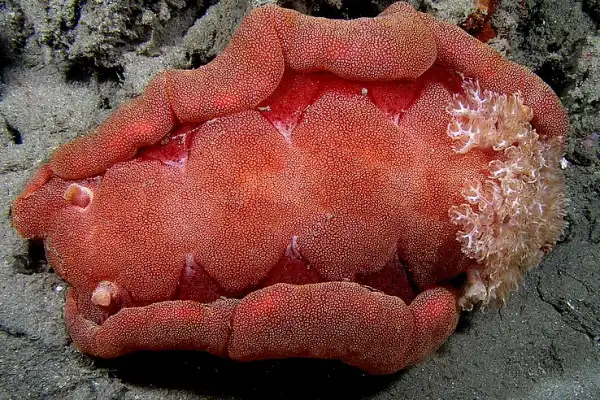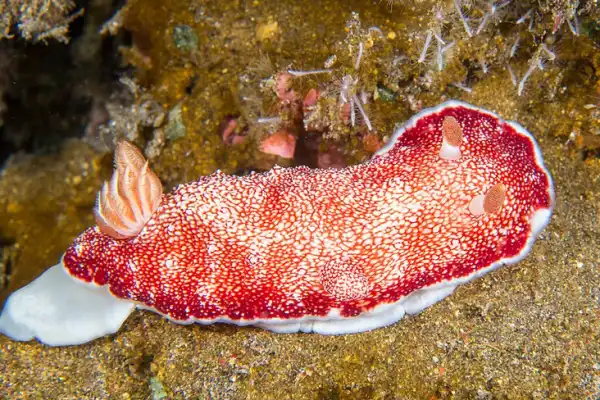Slugs are shellless molluscs. Some of them might have an internal shell, and their body is prone to desiccation since they usually don’t possess a shell. They create a protective mucus around them to overcome this problem.
Different slug species can have different color varieties, which serve important purposes for each slug species, apart from enhancing their beauty only. Today we are going to talk about the red-colored sea slugs.
15 Red Sea Slug Species
1) Spanish Dancer

| Scientific Name | Hexabranchus sanguineus |
| Size | 25 cm to maximum of 40 cm. |
| Geographic Location | Western Indian Ocean, Western Pacific, and The Red Sea. |
| Identification | Bright red body with white stripes and white dots. |
This slug species is Carnivorous and feeds on toxic sponges. Their bright coloration is a warning signal to potential predators and when they feel threatened, they flap their appendages and rhythmically move their body, almost like a Spanish dancer. Divers often bear witness to such a majestic creature.
These are among the largest nudibranch species. The most common form of Hexabranchus sanguineus has its mantle appendages in a mottled form.
Their eggs are ribbon-shaped which can be found on the rocks or corals. These eggs are very toxic, even than the adults.
2) Splendid Sea Slug
| Scientific Name | Goniobranchus splendidus |
| Size | Up to 5 cm. |
| Geographic Location | New South Wales and Southern parts of Queensland. |
| Identification | White-colored body with bright red spots. |
The “Splendida” term refers to the contrasting red spots present over a white-colored body. They also have a yellow-edged mantle.
The red spots often coalesce in the middle region of the body to form a large patch in some species. Their rhinophores are bright red and the white gills are covered with a prominent red lining.
3) Dusky Nembrotha
| Scientific Name | Nembrotha kubaryana |
| Size | Maximum of 120 mm. |
| Geographic Location | Various parts of the Western Indo-Pacific region. |
| Identification | Red pustules over a black body. The gills, sensory tentacles, and mantle ridge are red. |
These slugs feed on different toxic ascidians (such as sea squirts) and store the toxins in their own body. When they encounter any predators, they release these toxins in a slimy mucous form to defend themselves.
Another variant of this slug species exists, which has green stripes of pustules present over the black body.
4) Reticulated Chromodoris

| Scientific Name | Goniobranchus reticulatus |
| Size | Usually between 27 mm to 34 mm. |
| Geographic Location | Indo-West Pacific Ocean. |
| Identification | The upper body is reddish-brown with white spots. The lower part is pure white. Yellow tentacles. |
These slugs are hermaphroditic, meaning they have their male and female sex organs active simultaneously. The foot is long and extends the mantle in length.
The red pattern is reticulated, hence the name “reticulatus”. Rhinophores are usually yellowish and the white gills have yellow margins. Their coloration pattern gives them a “Fiery” look.
5) Flabellina nobilis
| Scientific Name | Flabellina nobilis |
| Size | Generally between 40 mm to 50 mm. |
| Geographic Location | Coasts of Northern America, Greenland, and Iceland. |
| Identification | White translucent body with maroon red cerata. The cerata have a white tip on top. |
Their favorite meal is the hydroids, which is why these slugs are generally found in the rocky slopes or reefs where rich in hydroids. They have a long sharp-ended tail.
The body is covered with long flattened extensions called cerata, which are evenly distributed through the upper body. The rhinophores are long and feather-like and sometimes are covered with warts, due to which they might appear wrinkled.
There are other members of this genus such as Flabellina verrucosa, Flabellina gracilis, etc.
6) Bornella pele

| Scientific Name | Bornella pele |
| Size | Small, usually up to 2 cm. |
| Geographic Location | Found in Hawaii, Japan, and Northeastern Australia. |
| Identification | Elongated body with patches of red color on the top of the head and the tail-end. |
The name “Pele” refers to the Hawaiian goddess of volcanoes, lightning, and fire, because of the red splashes of color present in these slug species. This red coloration is present in various parts such as the oral tentacles, the base rhinophores, on the dorsolateral processes.
7) Strawberry Nudibranch
| Scientific Name | Gymnodoris aurita |
| Size | Around 9 cm. |
| Geographic Location | Widely found in the Indo-West Pacific waters. |
| Identification | Bright Red body with yellow mantle edge and yellowish-white pustule-like structures on the upper body. |
They are generally found in shallow coral reefs, or sandy areas, usually in pairs or as single individuals. These slugs feed on Cnidarians and keep the stinging cells of cnidarians for their defense purpose.
These slugs have exceptionally large gills, and they move by muscular contraction with the help of tiny hairs on their foot.
8) Three-Horned Cretasoma
| Scientific Name | Ceratosoma trilobatum |
| Size | 15 cm on average. |
| Geographic Location | Throughout various waters of the Indo-Pacific Region. |
| Identification | Bright Red body often with orangish-red or yellow spots present. Purple mantle margin with three mantle lobes. |
A special curved dorsal “Horn”-like structure covers their gills, which can lure potential prey and release chemicals to ward off predators.
Some of the members of this species lack the spots and the coloration also varies, although always with bright colors. Their gills have a small flower-like appearance.
9) Diaphorodoris papillata Sea Slug
| Scientific Name | Diaphorodoris papillata |
| Size | 10 mm on average. |
| Geographic Location | Found in the Strait of Gibraltar and the coast of Portugal. |
| Identification | White-translucent body with deep red cerata on the upper body. The mantle margin is yellow. |
Their body might not have many color variations, but the red-club-shaped cerata and yellow mantle edge over the white background give a beautiful contrasting effect.
These slugs were first reported from the Canary Islands in the year 2016 and they mainly feed on different forms of bryozoans.
10) Aeolidiella sanguinea Sea Slug
| Scientific Name | Aeolidiella sanguinea |
| Size | Around 46 mm. |
| Geographic Location | Atlantic Coast, Ireland. |
| Identification | Their body and cerata have red coloration. |
The name “Sanguinea” means “bloody”, which signifies the red coloration present in the body. These slug species are rarely seen.
The tips of the cerata in some members have white tips. They feed mainly on anemones, such as Sagarita elegans.
11) Chamberlain’s Nembrotha
| Scientific Name | Nembrotha chamberlaini |
| Size | Up to 100 mm |
| Geographic Location | Generally found in the Philippines and Indonesia. |
| Identification | Bright Red gills and Rhinophores. |
The mantle has a white body color with a dark-brown patch. But the prominent feature is their red-colored gills and sensory rhinophore tentacles which are visually stunning.
Some species may have reddish-brown body colors also on their body. Their coloration pattern acts as a warning sign for potential predators.
12) Red Sponge Dorid
| Scientific Name | Rostanga pulchra |
| Size | Maximum of 30 mm. |
| Geographic Location | Various Coasts of the Pacific Ocean. |
| Identification | Bright Reddish-orange color on the upper body. |
These slugs are known to retain the red pigment that they obtain from the red sponges (for example Ophlitaspongia) they devour. Since they have a short body size with reddish-orange coloration, they almost look like sponges they feed on.
The eggs also appear to be red in color. The eggs are laid in a spiral-ribbon-like fashion. The slugs are usually found under the boulders and rocks of the ocean.
13) Aldisa smaragdina Slug
| Scientific Name | Aldisa smaragdina |
| Size | Maximum of 30 mm. |
| Geographic Location | Mediterranean and coasts of the Atlantic Ocean. |
| Identification | Broad red body with two dark spots on the back and some species might have a transverse white band across the mantle. |
The A.smaragdina have great camouflaging ability since the two darker spots closely resemble the inhalant pores Phorbas fictitious sponges.
These slugs also act as a source of a progesterone homolog. This species is often confused with the Aldisa banyulensis.
14) Aegires malinus Slug
| Scientific Name | Aegires malinus |
| Size | Up to 15 mm. |
| Geographic Location | Generally found in the Batangas region of the Phillippine islands. |
| Identification | Reddish-brown body with raised rhinophores of white color. The rhinophores also have brown spots. |
These slugs are very different than the other members of the Aegires Genus of slugs, both in terms of structure and color. There are some tubercules and lobe-like frills that are apple-greenish in color and surround the gills and rhinophores.
The protective tubercules are smaller than the gills found in this genus of slugs.
15) Chromodoris sphoni
| Scientific Name | Chromodoris sphoni |
| Size | Very Small, 40 mm on average. |
| Geographic Location | Tropical eastern coasts of the Pacific, Galapagos islands, and Gulf of Mexico. |
| Identification | The body is bright red with yellow strips and dots. Whitish-blue bands are present on the body. |
These slug species have beautiful coloration patterns present on their bodies, with a mixture of red, yellow, and bluish-white. The tips of the rhinophores and gills are dark to dark-purplish.
Often people confuse them with another species Hypselodoris agassizii, but the color pattern in the latter is a bit darker and the entire rhinophores are black.
Conclusion
The nudibranchs or shell-less sea slugs are colorful wonders of the sea. Since they lack a protective shell, these colors help them camouflage and hide in the environment. It also helps them to send warning signals to predators.
There are certain instances where other slug species can mimic the red-colored sea slugs to fend off predators. The red color provides them with a bright and attractive look.
Hi everyone. I am Sagnik. Biology has always fascinated me since my school days and that interest motivated me to pursue a Bachelor’s degree in Zoology and a Master’s degree in Biotechnology. I learned a lot of new interesting facts and information regarding the biological world we are part of. After obtaining my degree, I started working as a biology teacher through which I am able to teach students the various concepts that I have learned. Apart from my love for this subject, my passion lies in music, and I teach guitar as well. Photography, Reading comics, Drawing, and video editing are some of my other hobbies. I welcome you to a journey with me, where I will share my knowledge and excitement for the living world through my writings with you all.
